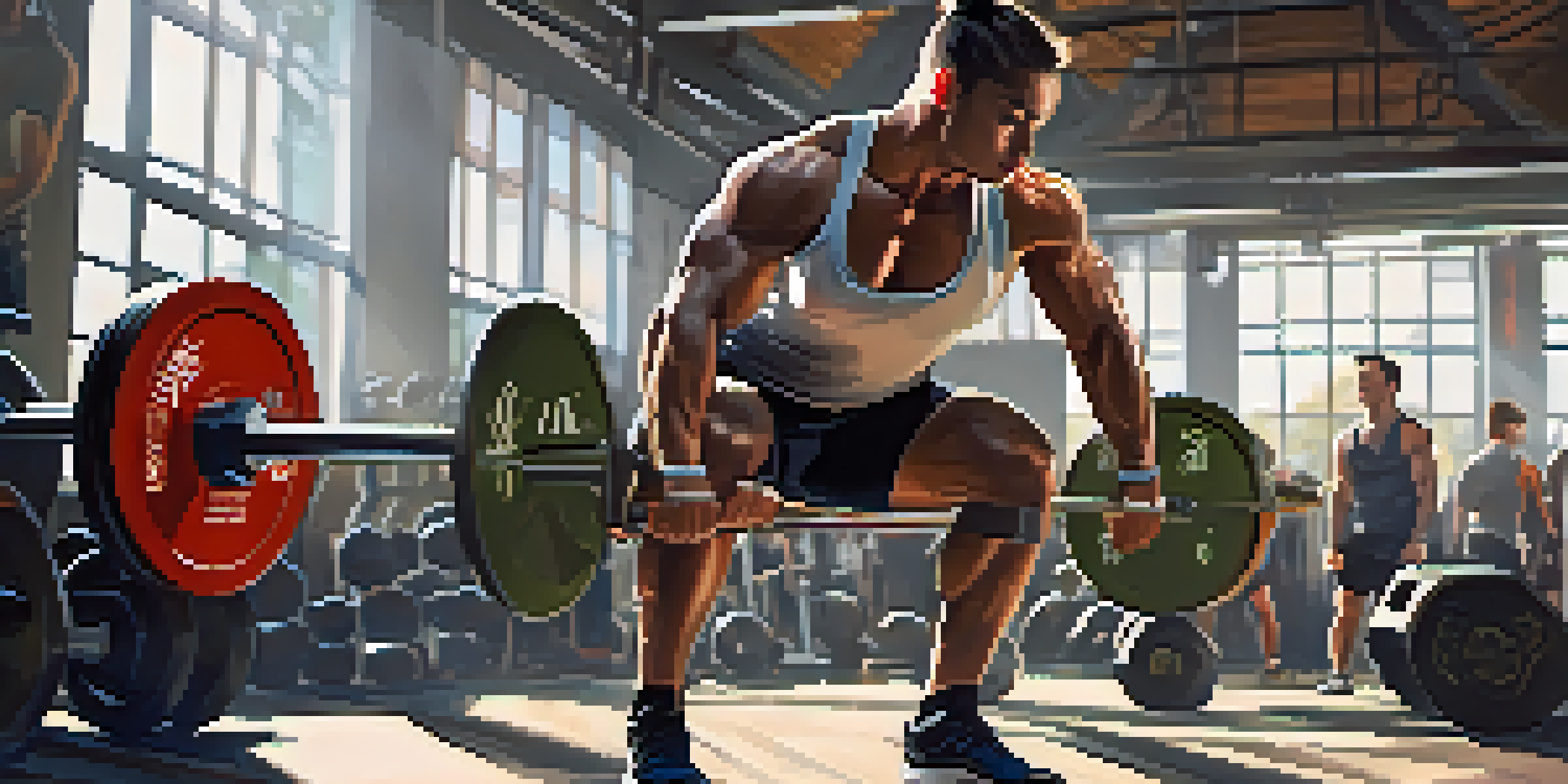Powerlifting vs. Cardio: Which is Better for Fat Loss?

Understanding Powerlifting and Its Benefits
Powerlifting is a strength sport focused on three main lifts: the squat, bench press, and deadlift. This discipline emphasizes building muscle mass and strength, which can significantly boost your metabolism. When you lift heavy weights, your body continues to burn calories even after your workout, a phenomenon known as the 'afterburn effect.'
Strength does not come from physical capacity. It comes from an indomitable will.
In addition to metabolic benefits, powerlifting can enhance overall functional strength, making everyday tasks easier. Imagine carrying groceries or lifting furniture; stronger muscles simplify these activities. Moreover, the sense of accomplishment that comes from hitting new personal records can be a huge motivational boost.
Powerlifting also fosters a strong sense of community, whether you’re lifting in a gym or competing in meets. This camaraderie can be encouraging and help you stay committed to your fitness journey. So, if you thrive in a supportive environment and enjoy the idea of building strength, powerlifting might be your ideal choice.
Exploring Cardio and Its Fat Loss Effects
Cardio, short for cardiovascular exercise, includes activities like running, cycling, and swimming. It's well-known for its ability to torch calories during workouts, which can lead to fat loss. For many, the immediate calorie burn makes cardio appealing, especially for those looking to drop pounds quickly.

One of the major advantages of cardio is its accessibility; you don’t need fancy equipment or a gym membership to get started. Whether it’s jogging in your neighborhood or dancing in your living room, the options are endless. Plus, the variety keeps workouts fresh and fun, helping to maintain your motivation over time.
Powerlifting Builds Strength and Muscle
Engaging in powerlifting not only enhances muscle mass and strength but also boosts your metabolism through the 'afterburn effect.'
However, it's essential to note that while cardio is excellent for burning calories, it may not build muscle like powerlifting does. This means that while you might lose fat, you could also lose some muscle mass if cardio is your only focus. Striking a balance between cardio and strength training could be the key to reaching your fat loss goals.
Caloric Deficit: The Key to Fat Loss
Regardless of your chosen exercise method, fat loss ultimately hinges on maintaining a caloric deficit. This means you're burning more calories than you consume, forcing your body to utilize stored fat for energy. Both powerlifting and cardio can contribute to this deficit, but they do so in different ways.
The difference between a successful person and others is not a lack of strength, not a lack of knowledge, but rather a lack in will.
For instance, powerlifting helps build muscle, which can increase your resting metabolic rate. This means that even when you’re not exercising, your body burns more calories than it would if you had less muscle. On the other hand, cardio directly burns calories during the workout, providing an immediate impact on your caloric balance.
Finding the right caloric deficit for your body is crucial; too large a deficit can lead to muscle loss and fatigue. Whether you prefer powerlifting, cardio, or a blend of both, it's essential to ensure your diet supports your exercise regimen and keeps you energized.
Combining Powerlifting and Cardio for Optimal Results
The best approach for fat loss may not be choosing one over the other but rather combining both powerlifting and cardio. By integrating strength training with cardiovascular workouts, you can maximize your fat-burning potential. This combination allows you to benefit from muscle building while also enjoying the calorie-burning effects of cardio.
For example, you might powerlift three days a week and incorporate cardio on alternate days. On powerlifting days, focus on heavy lifts and strength, while cardio days could involve moderate-intensity activities like jogging or cycling. This ensures you’re not overworking your muscles while still keeping your heart rate up.
Cardio Burns Calories Effectively
Cardiovascular exercises are highly effective for immediate calorie burning, making them a popular choice for fat loss.
Moreover, incorporating different types of cardio, such as high-intensity interval training (HIIT), can keep your workouts exciting and effective. HIIT can also boost your metabolism for hours after your session, complementing the strength gains from powerlifting seamlessly.
Individual Preferences: What Works Best for You?
Choosing between powerlifting and cardio often comes down to personal preference and fitness goals. Some individuals thrive on the structure and challenge of powerlifting, while others find joy in the rhythm and flow of cardio workouts. It's crucial to choose an exercise that you enjoy, as this will increase your chances of sticking with it long-term.
Consider your lifestyle and what you enjoy doing. If lifting weights excites you and you love seeing your strength improve, powerlifting may be your best bet. Conversely, if you prefer activities that get your heart racing and make you feel energetic, cardio could be the way to go.
Ultimately, listening to your body and adjusting your workout routine based on how you feel is vital. Exploring different workouts can help you discover what you truly love, leading to a sustainable fitness journey that supports your fat loss goals.
The Role of Nutrition in Fat Loss
While exercise is essential for fat loss, nutrition plays an equally critical role. No matter how much you lift or how many miles you run, poor dietary choices can counteract your hard work. A balanced diet rich in whole foods, lean proteins, healthy fats, and plenty of fruits and vegetables can support your fitness efforts while keeping you satiated.
It’s also vital to stay hydrated and pay attention to portion sizes. Even the healthiest foods can contribute to weight gain if consumed in large quantities. Incorporating a variety of foods will not only provide essential nutrients but also keep your meals interesting and enjoyable.
Balance Exercise for Optimal Results
Combining powerlifting and cardio can maximize fat loss by leveraging the benefits of both strength training and calorie-burning workouts.
Additionally, consider tracking your food intake to better understand your eating habits. This practice can help you identify areas for improvement and ensure you're fueling your body appropriately for your workouts, whether you’re powerlifting or doing cardio.
Conclusion: Finding Balance and Enjoyment in Your Fitness Journey
In the end, the debate between powerlifting and cardio for fat loss isn’t black and white. It’s about finding a balance that works for you, your body, and your lifestyle. Whether you choose to lift heavy, run long distances, or mix both approaches, the key is to stay consistent and enjoy the process.
Remember, the best workout is the one you enjoy and can sustain over time. Embrace the journey and celebrate your progress, regardless of whether it’s measured in pounds lost or personal records achieved. Each step forward counts, and your fitness journey is uniquely yours.

So, whether you're crushing weights in the gym or hitting the pavement for a run, know that you’re on the right path as long as you’re committed to your goals. Both powerlifting and cardio can lead to successful fat loss, so choose what inspires you and keep moving forward!